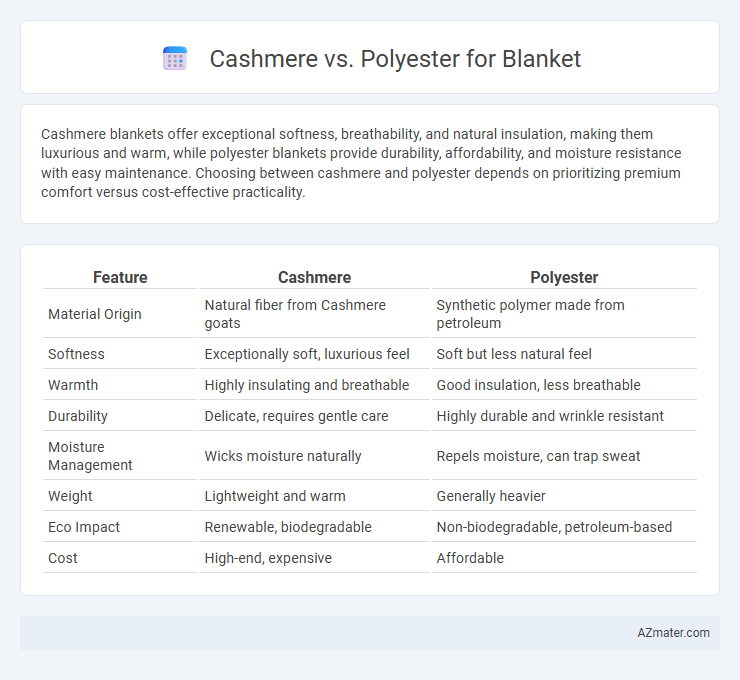Cashmere blankets offer exceptional softness, breathability, and natural insulation, making them luxurious and warm, while polyester blankets provide durability, affordability, and moisture resistance with easy maintenance. Choosing between cashmere and polyester depends on prioritizing premium comfort versus cost-effective practicality.
Table of Comparison
| Feature | Cashmere | Polyester |
|---|---|---|
| Material Origin | Natural fiber from Cashmere goats | Synthetic polymer made from petroleum |
| Softness | Exceptionally soft, luxurious feel | Soft but less natural feel |
| Warmth | Highly insulating and breathable | Good insulation, less breathable |
| Durability | Delicate, requires gentle care | Highly durable and wrinkle resistant |
| Moisture Management | Wicks moisture naturally | Repels moisture, can trap sweat |
| Weight | Lightweight and warm | Generally heavier |
| Eco Impact | Renewable, biodegradable | Non-biodegradable, petroleum-based |
| Cost | High-end, expensive | Affordable |
Introduction to Cashmere and Polyester Blankets
Cashmere blankets are crafted from the soft undercoat of cashmere goats, renowned for their exceptional warmth, lightweight feel, and luxurious texture, making them a premium choice for cold weather comfort. Polyester blankets, made from synthetic fibers, offer durability, resistance to wrinkles and stains, and are generally more affordable, providing versatile options for everyday use. Both materials cater to different needs, with cashmere emphasizing natural softness and breathability, while polyester focuses on practicality and ease of care.
Material Overview: What is Cashmere?
Cashmere is a natural fiber derived from the undercoat of Cashmere goats, renowned for its exceptional softness, warmth, and lightweight qualities, making it a premium choice for blankets. Unlike synthetic fibers such as polyester, Cashmere offers superior insulation and breathability, providing comfort in varying temperatures. This luxurious material is often more expensive due to the labor-intensive harvesting process and limited supply.
Material Overview: What is Polyester?
Polyester is a synthetic fiber derived from petrochemicals, known for its durability, wrinkle resistance, and affordability in blanket production. Unlike natural fibers like cashmere, polyester offers moisture-wicking properties and easy maintenance, making it popular for everyday use. Its ability to retain color and resist shrinking or stretching provides long-lasting performance in various blanket styles.
Softness and Comfort Comparison
Cashmere blankets offer exceptional softness and superior warmth due to their fine, natural fibers, making them highly breathable and comfortable against the skin. Polyester blankets, while often more affordable and durable, lack the natural softness of cashmere and can feel less breathable, sometimes causing discomfort during extended use. For those prioritizing luxurious softness and comfort, cashmere remains the preferred choice over polyester.
Warmth and Insulation Properties
Cashmere blankets provide superior warmth and insulation due to their fine, natural fibers that trap heat efficiently while remaining breathable. Polyester blankets, made from synthetic fibers, offer decent insulation but lack the natural thermoregulation properties of cashmere, often causing overheating or reduced moisture control. The densely woven structure of cashmere enhances its ability to retain body heat, making it a preferred choice for optimal warmth and comfort in colder climates.
Durability and Longevity
Cashmere blankets offer exceptional softness but require delicate care to maintain their durability, as the natural fibers can be prone to pilling and wear over time. Polyester blankets provide superior durability and longevity due to their synthetic fibers, which resist stretching, shrinking, and wrinkling, making them ideal for frequent use. The resilience of polyester ensures that these blankets retain their shape and color much longer than cashmere, which is more susceptible to damage from washing and prolonged exposure.
Maintenance and Care Requirements
Cashmere blankets require gentle hand washing or dry cleaning to preserve their softness and prevent damage, while polyester blankets are machine washable and dry quickly with minimal care. Cashmere's delicate fibers can shrink or become misshapen if exposed to high heat or harsh detergents, whereas polyester is more resistant to wrinkles, stains, and fading. Proper storage in a cool, dry place is essential for cashmere to avoid moth damage, unlike polyester which resists pests and mold effectively.
Hypoallergenic and Skin Sensitivity Factors
Cashmere blankets offer superior hypoallergenic properties due to their natural fibers, which reduce the risk of skin irritation and allergic reactions. Polyester blankets, while often more affordable, can trap heat and moisture, potentially exacerbating skin sensitivity and causing discomfort. Choosing cashmere supports better breathability and moisture-wicking, making it an ideal option for individuals with sensitive skin or allergies.
Price and Value Analysis
Cashmere blankets typically command higher prices due to the luxury and softness of the natural fibers, often ranging from $200 to over $1,000 depending on quality and weave. Polyester blankets are significantly more affordable, generally priced between $20 and $100, offering durability and ease of care but lacking the premium warmth and breathability of cashmere. When analyzing value, cashmere blankets provide long-term comfort and exclusivity, making them a worthwhile investment for those seeking luxury, whereas polyester serves as a cost-effective option for budget-conscious buyers prioritizing practicality.
Environmental Impact and Sustainability
Cashmere blankets, derived from the undercoat of Cashmere goats, are biodegradable and renewable but involve high water usage and land degradation during production, impacting fragile ecosystems. Polyester blankets, made from petroleum-based synthetic fibers, contribute significantly to microplastic pollution and are non-biodegradable, leading to long-term environmental harm in oceans and landfills. Sustainable choices favor ethically sourced Cashmere with certified standards, while recycled polyester offers a lower carbon footprint alternative compared to virgin synthetic fibers.

Infographic: Cashmere vs Polyester for Blanket
 azmater.com
azmater.com